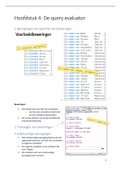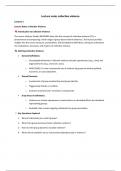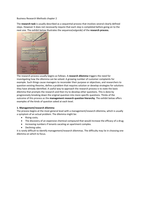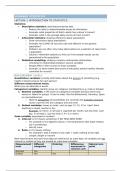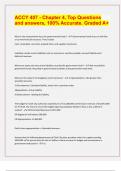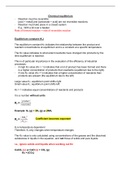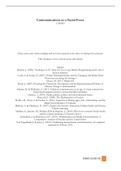LRM3702 – LABOUR RELATIONS MANAGEMENT: MICRO
TOPIC 3: TOTAL QUALITY LABOUR RELATIONS (TQLR): HOLISTIC AND
STRATEGIC PERSPECTIVES AND CHALLENGES
LEARNING UNIT 6
MANAGING LABOUR RELATIONS STRATEGICALLY: HOLISTIC AND INTEGRATIVE
PERSPECTIVES
6.1 INTRODUCTION
Management’s task is primarily to find ways to enable organisations to successfully convert inputs (capital, raw
materials, labour, etc) into outputs (products and services). From a systems perspective this is achieved through the
creation and coordination of various subsystems.
Labour may be viewed as one of the organisation’s primary resources. The employment relations subsystem in an
organisation is that part of the organisation that revolves around the management of labour as a primary input into
the organisation. This subsystem must therefore also be managed in such a way that value is added to the inputs, in
order to produce outputs which satisfy the needs of the community and also address the expectations and interests of
all other stakeholders.
Apart from these day-to-day decisions and operational activities of labour relations management in organisations we
also need to take strategic decisions about the management of this subsystem. This means adopting a holistic and
integrative approach to labour relations management. It means we must actively make connections between
employment relations and other elements inside and outside organisations. In this study unit, we focus on these
strategic aspects of labour relations management.
Management can essentially be defined as "a process of activities that are carried out to enable a business to
accomplish its goals by employing human, financial and physical resources for that purpose" (Erasmus, Strydom &
Rudansky-Kloppers 2013:136). Management therefore refers to the process in which managers attempt to use their
human and other resources as effectively and efficiently as possible to ensure that the organisation achieves its goals.
According to the process school of thought, this management process consists of the tasks of planning, organising,
leading or directing and control.
In a business context, managers understand strategy as their large-scale, future oriented plans for interacting with the
competitive environment to achieve organisational objectives. Viljoen and Dann (2003:6) emphasise that strategy, in a
management context, is concerned with "moving whole organisations from their current position to a desired
position."
Strategic management therefore means the process whereby all the organisational functions and resources are
integrated and coordinated to develop and implement strategies aligned with the environment, in order to achieve
the long-term objectives of the organisation and therefore gain a competitive advantage by adding value for the
stakeholders (Lazenby 2014:2).
Smit et al (2011:8-9) define management as the process of planning, organising, leading and controlling the resources
of the organisation to achieve stated organisational goals as productively as possible.
Planning is the management function that determines the organisation’s mission and goals. It involves identifying
ways of realising the goals and finding the resources needed for the task. It entails determining the future position of
the organisation and the strategies needed to reach that position.
Organising involves allocating the organisation’s human and other resources to the relevant departments or
individuals once the goals and plans have been determined.
Tasks, roles and responsibilities have to be defined and policies and procedures established to achieve the goals. Thus
organising involves developing a framework or organisational structure to indicate how people and other resources
should be deployed to achieve the goals. An organisation’s success lies in directing the different resources towards the
Page 1 of 43
Summary by L Petzer
, LRM3702 – LABOUR RELATIONS MANAGEMENT: MICRO
achievement of a common set of goals. The better the resources are coordinated and organised, the more successful
the organisation will be.
Leading refers to directing the human resources of the organisation and motivating them in such a way that their
actions are aligned with previously formulated goals and plans.
Control means that managers should constantly make sure that the organisation is on the right course to attain its
goals. The aim of control is therefore to monitor performance and action, ensuring that they conform to plans to
attain the predetermined goals. Control also enables management to identify and rectify any deviations from the
plans, and to take into account factors which might oblige them to revise their goals and plans (Smit et al 2011:9–11).
The process of strategic management essentially comprises a number of components that encompasses
environmental scanning and analysis, strategy formulation, implementation and evaluation. Because the time focus
of strategic management is long term, the planning component revolves around the organisation’s vision, mission,
strategies and long-term goals. Strategy formulation relates to the task of analysing the organisation’s external and
internal environment and then selecting an appropriate strategy (Hill, Jones & Schilling 2015:4). It entails selecting the
organisation’s mission and goals; analysing the organisation’s external competitive environment to identify strengths,
weaknesses, opportunities and threats (SWOT analysis); and selecting strategies that build on the organisation’s
strengths and correct its weaknesses in order to take advantage of external opportunities and counter external
threats.
Corporate strategy is concerned with the overall purpose and scope of an organisation and how value will be added to
the different parts (business units) of the organisation, whereas business strategy is about how to compete
successfully in particular markets (Slabbert et al 2006:7–11). Many authors also refer to business strategy as generic
strategy. Generic strategies are therefore more specific strategies that organisations can pursue in order to coordinate
their efforts towards the attainment of their long-term goals (Pearce & Robinson 2011:185). An organisation’s generic
strategies characterise its competitive orientation in the marketplace. Low-cost, differentiation or focus strategies
define the three fundamental options. The grand strategy, on the other hand, is a comprehensive, general plan of
major actions through which an organisation intends to achieve its long-term objectives in a dynamic environment
(Pearce & Robinson 2011:189).
No matter how carefully strategies are formulated or crafted, they have to be successfully implemented. Strategy
implementation can be defined as the process that turns strategic plans into a series of action tasks, and ensures that
these tasks are executed in such a way that the objectives of the strategic plan are achieved. In other words, strategy
implementation is the communication, interpretation, adoption and enactment of strategic plans.
The strategy evaluation component is on-going and ever present. It has to do with control in the context of the general
management process. Strategic evaluation or control provides feedback on the formulation and implementation
phases of the strategic management process. This feedback indicates the adjustments an organisation will need to
make in order to align itself better with its environment and improve the likelihood of successful strategy
implementation. Strategic control or strategy evaluation results may lead to changes in the choice of strategy or to
changes in how the strategy is being implemented.
The results could also lead to changes in both the formulation and implementation phases, or may show no need for
any changes at all. Strategic evaluation or control is in essence the phase of the strategic management process that
focuses on evaluating the chosen strategy in order to verify whether the results produced by the strategy are those
intended (Lazenby 2014:384).
6.2 STRATEGY FORMULATION DECISIONS IN LABOUR RELATIONS MANAGEMENT
Pearce and Robinson (2011:3), define strategic management as "the set of decisions and actions that result in the
formulation and implementation of plans designed to achieve a company’s objectives". According to Brevis and Vrba
(2014:263), decision making is "the process of selecting an alternative course of action that will solve a problem". On
the basis of the information available to top management as the competitive external environment changes, top
Page 2 of 43
Summary by L Petzer
, LRM3702 – LABOUR RELATIONS MANAGEMENT: MICRO
management are constantly confronted with alternative choices on how the different dimensions of the employment
relationship should be managed in order to promote the organisation’s survival or success in the long term.
Decision making about employment relations strategy is not a simple matter. "Alternative" elements (in other words,
elements other than those of the rational process) play a vital role in such decision making. One of these involves the
thought patterns or frames of reference of the persons involved in such decision making. Decision makers’ thought
patterns do have a crucial influence on the nature and development of labour relations in an organisation. The
decisions that are taken, the behaviour of role players and the patterns of interaction between them, are all strongly
influenced by these parties’ attitudes or frames of reference – sometimes directly, and sometimes more subtly and
indirectly.
Strategic choices and decisions relating to employment relations management, such as those concerned with
collective bargaining, job evaluation systems and worker participation are influenced by the way in which managers
perceive the environment. The way in which management perceive the environment is, in turn, influenced by
"management ideology" (values/philosophy) (Hirschhorn 1988:2). Values include basic beliefs about how to treat
employees, what motivates people to work harder and the role unions should play in the workplace and society
(Arthur 1990:48). Management’s philosophical opposition to unions, for example, guides its strategic decisions in
labour relations.
Through its ideological filter, management interpret events and develop policies and strategies to manage the
organisation’s interaction with the environment (Hirschhorn 1988:17).
The two primary cognitive frames of reference, perspectives or ideologies are the unitary perspective, whereby the
enterprise is viewed as having a unified authority structure common objectives and values, and the pluralist
perspective in terms of which the enterprise is viewed as being composed of a coalition of individuals and groups with
diverse objectives and values. Additional ideologies include the radical perspective, corporatism and concertation.
There are two primary cognitive frames of reference, perspectives or ideologies (Swanepoel1999b:11), namely the
1.Unitary perspective, according to which the enterprise is viewed as having a unified authority structure within
common objectives and values, interests and purpose. Conflict is generally regarded as rather unnecessary as
employees are expected to be loyal to management and “their” organisations. The underlying assumption is
that the people working in an organization are in basic harmony, and that conflict is understandable and mainly
a result of communication problems. This perspective basically denies the notion of inherent, built-in conflict
due to the nature of the employment relationship.
2. Pluralist perspective, in terms of which the enterprise is viewed as being composed of a coalition of individuals
and groups with diverse objectives, values and interests. The underlying assumption of this perspective is that
individuals in an organization combine into a variety of distinct sectional groups, each with its own interests,
objectives and leadership (either formal or informal). The different groups in the organization are competitive in
terms of leadership, authority and loyalty. This conflict puts the organization in a permanent state of dynamic
tension.
3. The Radical perspective draws on intellectual traditions related to Marxist thinking and it therefore essentially
reflects a “class conflict” worldview. Exponents of this approach concentrate more on the nature of the society
in which the organization finds itself. It assumed that workers are oppressed for the sake of capitalist interests
and hence there is emphasis on the class struggle between the “haves” and the “have-nots” so typically claimed
to be part of capitalist perspectives. Trade unions are viewed as an unavoidable response to capitalism.
One should be sensitive towards the assumptions and beliefs of managers and the political context within which
strategic evaluations and analyses are conducted and decisions made. The greatest obstacles are usually cultural and
political.
Management decisions on business strategy will be influenced by their perception of competitive threats and
opportunities in the environment as well as by pre-existing values or ideology of the organisation’s dominant coalition
Page 3 of 43
Summary by L Petzer
TOPIC 3: TOTAL QUALITY LABOUR RELATIONS (TQLR): HOLISTIC AND
STRATEGIC PERSPECTIVES AND CHALLENGES
LEARNING UNIT 6
MANAGING LABOUR RELATIONS STRATEGICALLY: HOLISTIC AND INTEGRATIVE
PERSPECTIVES
6.1 INTRODUCTION
Management’s task is primarily to find ways to enable organisations to successfully convert inputs (capital, raw
materials, labour, etc) into outputs (products and services). From a systems perspective this is achieved through the
creation and coordination of various subsystems.
Labour may be viewed as one of the organisation’s primary resources. The employment relations subsystem in an
organisation is that part of the organisation that revolves around the management of labour as a primary input into
the organisation. This subsystem must therefore also be managed in such a way that value is added to the inputs, in
order to produce outputs which satisfy the needs of the community and also address the expectations and interests of
all other stakeholders.
Apart from these day-to-day decisions and operational activities of labour relations management in organisations we
also need to take strategic decisions about the management of this subsystem. This means adopting a holistic and
integrative approach to labour relations management. It means we must actively make connections between
employment relations and other elements inside and outside organisations. In this study unit, we focus on these
strategic aspects of labour relations management.
Management can essentially be defined as "a process of activities that are carried out to enable a business to
accomplish its goals by employing human, financial and physical resources for that purpose" (Erasmus, Strydom &
Rudansky-Kloppers 2013:136). Management therefore refers to the process in which managers attempt to use their
human and other resources as effectively and efficiently as possible to ensure that the organisation achieves its goals.
According to the process school of thought, this management process consists of the tasks of planning, organising,
leading or directing and control.
In a business context, managers understand strategy as their large-scale, future oriented plans for interacting with the
competitive environment to achieve organisational objectives. Viljoen and Dann (2003:6) emphasise that strategy, in a
management context, is concerned with "moving whole organisations from their current position to a desired
position."
Strategic management therefore means the process whereby all the organisational functions and resources are
integrated and coordinated to develop and implement strategies aligned with the environment, in order to achieve
the long-term objectives of the organisation and therefore gain a competitive advantage by adding value for the
stakeholders (Lazenby 2014:2).
Smit et al (2011:8-9) define management as the process of planning, organising, leading and controlling the resources
of the organisation to achieve stated organisational goals as productively as possible.
Planning is the management function that determines the organisation’s mission and goals. It involves identifying
ways of realising the goals and finding the resources needed for the task. It entails determining the future position of
the organisation and the strategies needed to reach that position.
Organising involves allocating the organisation’s human and other resources to the relevant departments or
individuals once the goals and plans have been determined.
Tasks, roles and responsibilities have to be defined and policies and procedures established to achieve the goals. Thus
organising involves developing a framework or organisational structure to indicate how people and other resources
should be deployed to achieve the goals. An organisation’s success lies in directing the different resources towards the
Page 1 of 43
Summary by L Petzer
, LRM3702 – LABOUR RELATIONS MANAGEMENT: MICRO
achievement of a common set of goals. The better the resources are coordinated and organised, the more successful
the organisation will be.
Leading refers to directing the human resources of the organisation and motivating them in such a way that their
actions are aligned with previously formulated goals and plans.
Control means that managers should constantly make sure that the organisation is on the right course to attain its
goals. The aim of control is therefore to monitor performance and action, ensuring that they conform to plans to
attain the predetermined goals. Control also enables management to identify and rectify any deviations from the
plans, and to take into account factors which might oblige them to revise their goals and plans (Smit et al 2011:9–11).
The process of strategic management essentially comprises a number of components that encompasses
environmental scanning and analysis, strategy formulation, implementation and evaluation. Because the time focus
of strategic management is long term, the planning component revolves around the organisation’s vision, mission,
strategies and long-term goals. Strategy formulation relates to the task of analysing the organisation’s external and
internal environment and then selecting an appropriate strategy (Hill, Jones & Schilling 2015:4). It entails selecting the
organisation’s mission and goals; analysing the organisation’s external competitive environment to identify strengths,
weaknesses, opportunities and threats (SWOT analysis); and selecting strategies that build on the organisation’s
strengths and correct its weaknesses in order to take advantage of external opportunities and counter external
threats.
Corporate strategy is concerned with the overall purpose and scope of an organisation and how value will be added to
the different parts (business units) of the organisation, whereas business strategy is about how to compete
successfully in particular markets (Slabbert et al 2006:7–11). Many authors also refer to business strategy as generic
strategy. Generic strategies are therefore more specific strategies that organisations can pursue in order to coordinate
their efforts towards the attainment of their long-term goals (Pearce & Robinson 2011:185). An organisation’s generic
strategies characterise its competitive orientation in the marketplace. Low-cost, differentiation or focus strategies
define the three fundamental options. The grand strategy, on the other hand, is a comprehensive, general plan of
major actions through which an organisation intends to achieve its long-term objectives in a dynamic environment
(Pearce & Robinson 2011:189).
No matter how carefully strategies are formulated or crafted, they have to be successfully implemented. Strategy
implementation can be defined as the process that turns strategic plans into a series of action tasks, and ensures that
these tasks are executed in such a way that the objectives of the strategic plan are achieved. In other words, strategy
implementation is the communication, interpretation, adoption and enactment of strategic plans.
The strategy evaluation component is on-going and ever present. It has to do with control in the context of the general
management process. Strategic evaluation or control provides feedback on the formulation and implementation
phases of the strategic management process. This feedback indicates the adjustments an organisation will need to
make in order to align itself better with its environment and improve the likelihood of successful strategy
implementation. Strategic control or strategy evaluation results may lead to changes in the choice of strategy or to
changes in how the strategy is being implemented.
The results could also lead to changes in both the formulation and implementation phases, or may show no need for
any changes at all. Strategic evaluation or control is in essence the phase of the strategic management process that
focuses on evaluating the chosen strategy in order to verify whether the results produced by the strategy are those
intended (Lazenby 2014:384).
6.2 STRATEGY FORMULATION DECISIONS IN LABOUR RELATIONS MANAGEMENT
Pearce and Robinson (2011:3), define strategic management as "the set of decisions and actions that result in the
formulation and implementation of plans designed to achieve a company’s objectives". According to Brevis and Vrba
(2014:263), decision making is "the process of selecting an alternative course of action that will solve a problem". On
the basis of the information available to top management as the competitive external environment changes, top
Page 2 of 43
Summary by L Petzer
, LRM3702 – LABOUR RELATIONS MANAGEMENT: MICRO
management are constantly confronted with alternative choices on how the different dimensions of the employment
relationship should be managed in order to promote the organisation’s survival or success in the long term.
Decision making about employment relations strategy is not a simple matter. "Alternative" elements (in other words,
elements other than those of the rational process) play a vital role in such decision making. One of these involves the
thought patterns or frames of reference of the persons involved in such decision making. Decision makers’ thought
patterns do have a crucial influence on the nature and development of labour relations in an organisation. The
decisions that are taken, the behaviour of role players and the patterns of interaction between them, are all strongly
influenced by these parties’ attitudes or frames of reference – sometimes directly, and sometimes more subtly and
indirectly.
Strategic choices and decisions relating to employment relations management, such as those concerned with
collective bargaining, job evaluation systems and worker participation are influenced by the way in which managers
perceive the environment. The way in which management perceive the environment is, in turn, influenced by
"management ideology" (values/philosophy) (Hirschhorn 1988:2). Values include basic beliefs about how to treat
employees, what motivates people to work harder and the role unions should play in the workplace and society
(Arthur 1990:48). Management’s philosophical opposition to unions, for example, guides its strategic decisions in
labour relations.
Through its ideological filter, management interpret events and develop policies and strategies to manage the
organisation’s interaction with the environment (Hirschhorn 1988:17).
The two primary cognitive frames of reference, perspectives or ideologies are the unitary perspective, whereby the
enterprise is viewed as having a unified authority structure common objectives and values, and the pluralist
perspective in terms of which the enterprise is viewed as being composed of a coalition of individuals and groups with
diverse objectives and values. Additional ideologies include the radical perspective, corporatism and concertation.
There are two primary cognitive frames of reference, perspectives or ideologies (Swanepoel1999b:11), namely the
1.Unitary perspective, according to which the enterprise is viewed as having a unified authority structure within
common objectives and values, interests and purpose. Conflict is generally regarded as rather unnecessary as
employees are expected to be loyal to management and “their” organisations. The underlying assumption is
that the people working in an organization are in basic harmony, and that conflict is understandable and mainly
a result of communication problems. This perspective basically denies the notion of inherent, built-in conflict
due to the nature of the employment relationship.
2. Pluralist perspective, in terms of which the enterprise is viewed as being composed of a coalition of individuals
and groups with diverse objectives, values and interests. The underlying assumption of this perspective is that
individuals in an organization combine into a variety of distinct sectional groups, each with its own interests,
objectives and leadership (either formal or informal). The different groups in the organization are competitive in
terms of leadership, authority and loyalty. This conflict puts the organization in a permanent state of dynamic
tension.
3. The Radical perspective draws on intellectual traditions related to Marxist thinking and it therefore essentially
reflects a “class conflict” worldview. Exponents of this approach concentrate more on the nature of the society
in which the organization finds itself. It assumed that workers are oppressed for the sake of capitalist interests
and hence there is emphasis on the class struggle between the “haves” and the “have-nots” so typically claimed
to be part of capitalist perspectives. Trade unions are viewed as an unavoidable response to capitalism.
One should be sensitive towards the assumptions and beliefs of managers and the political context within which
strategic evaluations and analyses are conducted and decisions made. The greatest obstacles are usually cultural and
political.
Management decisions on business strategy will be influenced by their perception of competitive threats and
opportunities in the environment as well as by pre-existing values or ideology of the organisation’s dominant coalition
Page 3 of 43
Summary by L Petzer



